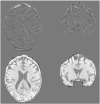Impact of scanner hardware and imaging protocol on image quality and compartment volume precision in the ADNI cohort
- PMID: 19913626
- PMCID: PMC2951115
- DOI: 10.1016/j.neuroimage.2009.11.006
Impact of scanner hardware and imaging protocol on image quality and compartment volume precision in the ADNI cohort
Abstract
Morphometry of brain structures based on magnetic resonance imaging (MRI) data has become an important tool in neurobiology. Recent multicenter studies in neurodegenerative diseases raised the issue of the precision of volumetric measures, and their dependence on the scanner properties and imaging protocol. A large dataset consisting of 1073 MRI examinations in 843 subjects, acquired on 90 scanners at 58 sites, is analyzed here. A comprehensive set of image quality and content measures is used to describe the influence of the scanner hardware and imaging protocol on the variability of morphometric measures. Scanners equipped with array coils show a remarkable advantage over conventional coils in terms of image quality measures. The signal- and contrast-to-noise ratio in similar systems is equal or slightly better at 1.5 T than 3.0 T, while the white/grey matter tissue contrast is generally better on high-field systems. Repeated MRI investigations on the same scanner were available in 41 subjects, on different scanners in 172 subjects. The retest reliability of repeated volumetric measures under the same conditions was found as sufficient to track changes in longitudinal examinations in individual subjects. Using different acquisition conditions in the same subject, however, the variance of volumetric measures was up to 10 times greater. Two likely factors explaining this finding are scanner-dependent geometrical inaccuracies and differences in the white/grey matter tissue contrast.
Copyright (c) 2009 Elsevier Inc. All rights reserved.
Figures







References
-
- Ashburner J, Friston KJ. Voxel-based morphometry—the methods. NeuroImage. 2000;11:805–821. - PubMed
-
- Baayen RH, Davidson DJ, Bates DM. Mixed-effects modeling with crossed random effects for subjects and items. J. Mem. Lang. 2008;59:390–412.
-
- Bishop CM. Neural networks for pattern recognition. Claredon Press; Oxford: 1995. p. 1995.
-
- Ewers M, Teipel SJ, Dietrich O, Sch'onberg SO, Jessen F, Heun R, Scheltens P, van de Pold L, Freymann NR, Moeller HJ, Hampel H. Multicenter assessment of reliability of cranial MRI. Neurobiol. Aging. 2005;27:1051–1059. - PubMed
Publication types
MeSH terms
Grants and funding
LinkOut - more resources
Full Text Sources
Medical

